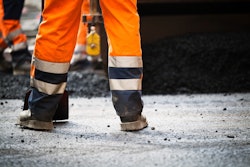New technologies and products can extend pavement life to help address the chronic pavement problems of the highway and bridge building industry.

A number of problems have converged to create a perfect storm that threatens the condition of the United States’ transportation infrastructure. Many U.S. interstate highways were built during the construction boom of the 1960s and 1970s, so a large percentage of those roads and bridges reached the end of their intended design lives at the same point in time. Most had experienced a greater-than-anticipated volume of traffic, which reduced their service lives. At the same time, the amount of funding available for repairs was not as great as had been originally anticipated and continues to be problematic, resulting in a large number of roads and bridges being used past their design lives.

Rapid-hardening cement is helping meet this challenge, as it sets and gains strength rapidly. When rapid-hardening cement combines with water (hydrates), it forms crystalline compounds much faster than does portland cement, getting traffic back on the road in less time.
Here are some projects that are using state-of-the-art paving solutions to save taxpayer dollars, while providing more durable and safer road surfaces.
Denver I-70 Bridge Repair
In the late 2000s, the I-70 bridge between State Highway 265 and State Highway 2 in Denver was one of 46 bridges in the metro Denver area that was being used past its intended design life. The Colorado Department of Transportation (CDOT) deemed it to be in imminent need of repair, since its 60 expansion joints had been corroded by water and salt and deterioration of the reinforcing steel and surrounding concrete had resulted. With bridge replacement being too costly, CDOT began a repair project to extend the life of the bridge an additional 10 to 15 years. Patching was completed in December 2010, and the whole bridge project was completed in Spring 2011.
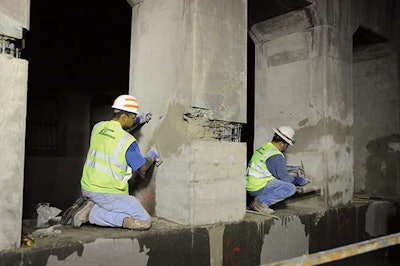
Route 95 Bridge Rehabilitation
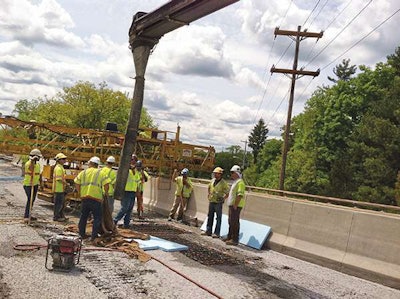
Crews milled the existing asphalt concrete and removed deteriorated concrete. Those areas were filled with a rapid-setting concrete that contained Rapid Set Low-P cement and fly ash. Rapid Set Low-P has low permeability and improved resistance to attack from chlorides and de-icing salts, and fly ash was added to eliminate any potential alkali silica reactivity problems. After patching, they placed a concrete overlayment; the 3-1/2- to 4-inch overlayment used the same rapid-setting concrete mix as the patched areas, a first for such a specification in Massachusetts. Concrete was mixed on site in mobile mixers, saving time and eliminating waste. This combination of techniques and materials demonstrated that bridge deck repair can be accomplished in a short period of time.
I-55 bridges near St. Louis area
Like many states, Missouri wanted to reduce lane-closure times while its bridge decks were being repaired. Many of the state DOT’s early experiments with materials offering fast cure times had proven to be non-durable. In 2008, the Missouri Department of Transportation (MoDOT) used Rapid Set Low-P Cement for the first time in one of its bridge overlays. Follow-up testing of the material indicated excellent compressive strengths, low permeability, good bonding properties and minimal shrinkage.
Based on Low-P’s earlier success, the St. Louis Area District approved its use. Concrete Strategies, the highway and bridge contractor on this project, performed work on a total of six overpasses using Low-P; in every case, compressive strengths, permeability and pull off tests were well within specified range.
Highway J Bridge
The Highway J Bridge near Chillicothe, Missouri, was scheduled for replacement as part of the state’s Safe & Sound Bridge Improvement Program – a program that involved improvements to 802 of Missouri’s worst bridges over the course of five years and is the largest bridge improvement project in the state’s history.
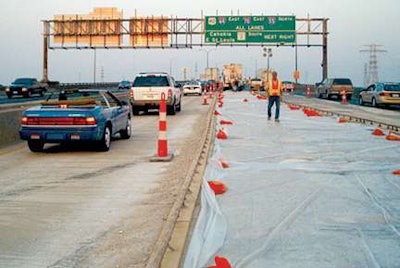
Because the pour occurred in hot weather, Rapid Set Control additive was added to increase the working time for an additional 5 to 10 minutes. FLOW Control was also used to produce a flowable mix, which eliminated voids within the keyway. Using fast-setting grout on the Highway J Bridge project achieved the strength required within the necessary time frame and helped keep the project on schedule; tests showed it reached between 7,000 to 10,000 psi within 18 to 24 hours.
Lewis and Clark Bridge
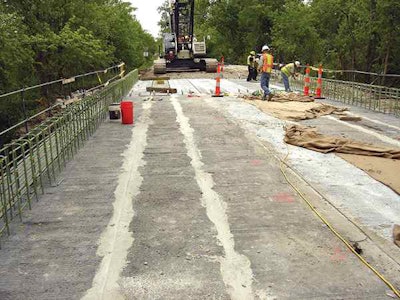
To help meet these demands, rapid-setting cement, with a final set time of 35 minutes, was used for areas of the bridge that could be repaired by applying a new concrete overlay: 450 cubic yards of the cement were used for the 1,575 foot length of overlay, and the work was performed during one weekend. The overlay achieved a compressive strength of 4,000 psi in four hours. Using this cement saved at least nine days compared to a slower-setting concrete overlay.
San Francisco-Oakland Bay Bridge
Seismic upgrades to the San-Francisco-Oakland Bay Bridge began in 2002. The west span (San Francisco side) was 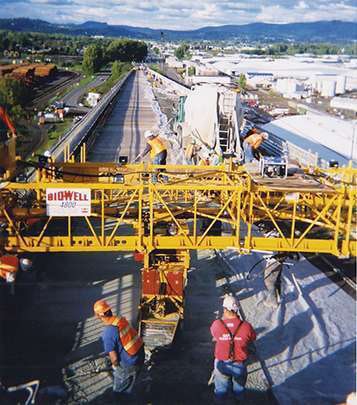
Because of the variety of materials being used to afford seismic safety, typical cement set times of 28 days were not practical. The steel suspension bridge can experience rapid expansion and contraction, so cement used at joints on the bridge needed to set within a four-hour window of time.
Quick-setting cement was used at the seismic joints on either side of the SAS so the concrete was able to set and achieve sufficient strength before bridge movement had time to occur. After construction was complete, concrete compression tests were performed at joint segments in time intervals of one, seven and 56 days.
All of the test results proved that the concrete strengths, measured in PSI, exceeded performance requirements and did so in a shorter time frame than was specified. A joint venture between American Bridge/Fluor was the bridge and highway contractor on this project.
Walkway over the Hudson
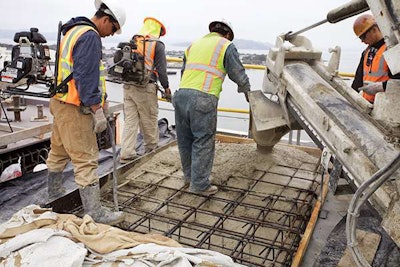
The new walking surface is comprised of precast concrete panels; panel installation involved placement over vertical posts that had been welded to the bridge’s girders and leveling and aligning the panels with leveling screws. Space between the panels and the bridge, as well as openings around the posts, were filled with a specially formulated, flowable and fast-setting grout.

The Rapid Set Cement-All grout offered a low-shrinkage, durable material for the closure pours that obtained the required strength within three hours.
This article and photos are courtesy of CTS Cement/Rapid Set Construction Cement.




